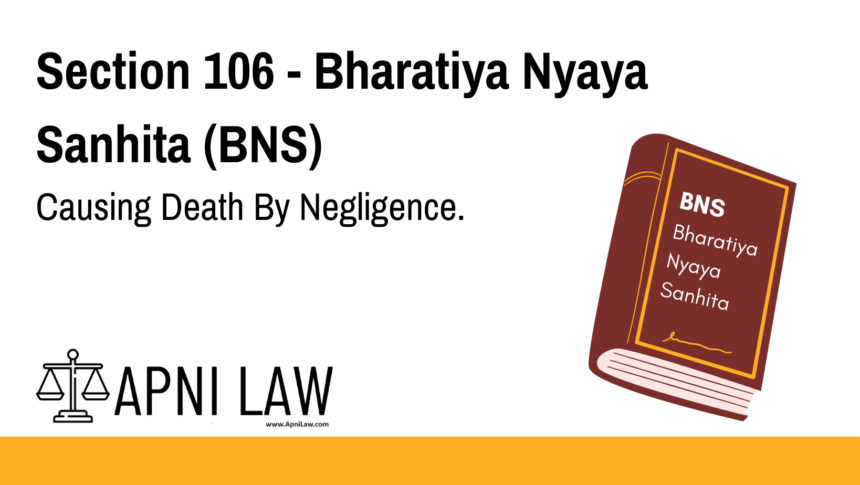Code
(1) Whoever causes death of any person by doing any rash or negligent act not
amounting to culpable homicide, shall be punished with imprisonment of either description
for a term which may extend to five years, and shall also be liable to fine; and if such act is
done by a registered medical practitioner while performing medical procedure, he shall be
punished with imprisonment of either description for a term which may extend to two years,
and shall also be liable to fine.
Explanation.— For the purposes of this sub-section, “registered medical practitioner”
means a medical practitioner who possesses any medical qualification recognised under the
National Medical Commission Act, 2019 and whose name has been entered in the National
Medical Register or a State Medical Register under that Act.
(2) Whoever causes death of any person by rash and negligent driving of vehicle not
amounting to culpable homicide, and escapes without reporting it to a police officer or a
Magistrate soon after the incident, shall be punished with imprisonment of either description
of a term which may extend to ten years, and shall also be liable to fine.
Explanation of Section 106 BNS
Section 106 of the Bharatiya Nyaya Sanhita (BNS), 2023, deals with cases where death is caused due to negligence rather than intentional harm. This provision applies when a person’s careless or reckless actions result in someone’s death, but without the intent to kill.
Key Elements of Section 106 BNS:
-
Act of Negligence or Rashness
- The person must have acted negligently or recklessly, leading to death.
- The act should not amount to culpable homicide (Section 105 BNS), which requires intention or knowledge.
-
Punishment
- Imprisonment: Up to 5 years.
- Fine: Amount at the discretion of the court.
- Both imprisonment and fine may be imposed based on the severity of negligence.
Illustrations
Example 1: Death Due to Medical Negligence
A surgeon performs a high-risk surgery but fails to follow standard medical procedures, leading to the patient’s death.
- Since the doctor’s actions were reckless but not intentional, it falls under Section 106 BNS.
- The doctor may face imprisonment of up to 5 years, a fine, or both.
Example 2: Death in a Road Accident Due to Rash Driving
A person drives a car recklessly through a crowded street, jumping signals, and hits a pedestrian, causing instant death.
- The driver’s act was negligent, but he did not intend to kill.
- He may face imprisonment of up to 5 years or a fine.
Example 3: Death Due to Workplace Negligence
A factory owner ignores safety protocols, leading to a gas leak that causes an employee’s death.
- The owner’s failure to ensure safety makes him liable under Section 106 BNS.
Common Questions and Answers on Section 106 BNS
1. How is Section 106 different from Section 105 BNS (Culpable Homicide Not Amounting to Murder)?
- Section 105 BNS applies when the accused has intent to cause injury or knowledge that death could result.
- Section 106 BNS applies when the death is purely due to negligence without intent or knowledge.
2. Is Section 106 BNS a bailable offense?
Yes, offenses under Section 106 BNS are bailable and can be compoundable, depending on court discretion.
3. What are some real-life cases where Section 106 applies?
- Hospital deaths due to medical negligence.
- Building collapses due to poor construction standards.
- Road accidents caused by reckless driving.
4. What is the maximum punishment under Section 106 BNS?
The maximum punishment is 5 years of imprisonment or a fine, or both.
5. Can someone charged under Section 106 BNS get acquitted?
Yes, if the accused proves that there was no negligence or rash act, they can be acquitted.
Conclusion
Section 106 BNS ensures accountability for negligent acts leading to death, distinguishing them from intentional killings. It plays a crucial role in cases of medical malpractice, road accidents, and industrial negligence.
For expert legal guidance, visit ApniLaw today! 🚀








